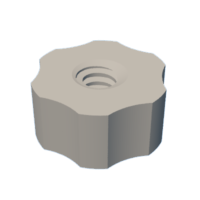Introduction: A Simple Wooden Puzzle
Make a simple wooden block puzzle that you can assemble in four different ways. Made from pretty hardwoods the puzzle will give you a nice desktop sculpture. The technique in steps 3 and 4 can also be used to create curved and wonky wooden posts or legs.
Supplies
2-1/2" by 2-1/2" by 6" hardwood block. This can be constructed from scrap pieces left over from your other projects
Wood glue
3d printed bolts and nuts, or 1/4" dowels, or 1/4" by 3" machine bolts & nuts
Sand paper
Table saw, band saw, clamps
Step 1: Make a Wooden Block
Start by making a wooden block that is 2.5 inches by 2.5 inches by 6 inches tall. Make sure that the block is square. Sand all faces before proceeding. Since I did not have 2.5 inches strong hardwood I laminated two pieces of cherry with a piece of walnut.
Step 2: Drill Holes
Drill twelve 1/4 inch diameter holes all the way through the block in the locations shown in the attached pdf template. Six holes on one face, then another six after turning the block 90 degrees. These holes are offset so they won’t intersect. I used a corner stop on the drill press table to quickly and accurately place all holes.
Attachments
Step 3: Make a Curvy Cut
Now draw a wavy line on each of two faces, straddling the centerline. Stay away from the holes; and try to make the lines curving gently. Bear in mind that you will make a bandsaw cut along these lines; so don’t make the curves too tight or complicated. As long as it looks good to you it’s fine!
Next take the block to the bandsaw and make a cut along the first curvy line. The line serves mostly as a rough guide and does not need to be followed accurately. It is more important that you make this cut in one smooth motion, without stopping or forcing; even if you don’t exactly stay on your drawn line. If you stop you will end up with saw marks (or a notch) which you will have to sand out later on. Try to avoid that. The pictures clearly show that I don't know how to follow a line; but the end result is quite pleasing and the cut is smooth.
If you have some scraps you can practice making a smooth curvy cut first. Of course, a sharp bandsaw blade helps. I am using a 1/4” wide blade.
Step 4: Make a Second Curvy Cut
Once you have the two pieces, tape them firmly back together with packing tape or blue tape. Then make a curvy cut on the second face, again going smooth and steady. Here again, I'm terrible at following my own line but the cut turned out very well.
You’ll end up with four 6" long pieces. For fun, stack them together in their curvy form; i.e. put together the straight outside faces. This is how you would glue up curvy legs for a stool or table.
Using cherry wood I got some burn marks, so I sanded the curved faces to remove the burns and minor saw marks. If you do that don’t take off too much; you want the opposing faces to mate each other well. Also, keep the edges square.
Step 5: Four More Cuts
Complete making the puzzle by cutting each piece 2 inches from the end; staggered, as shown in the pictures. This gives you 8 pieces for the entire puzzle.
Finish the puzzle pieces with mineral oil, cutting board finish, Danish oil, or varnish.
Step 6: Nuts & Bolts
To help with assembling the puzzle when playing with it I 3d printed some long bolts (1/4” diameter, 3-3/8" long, ACME thread, class 2G) and nuts. Wooden dowels/pegs would look better, but I had difficulty making them fit and hold in place. They were either too tight to insert, or too loose to hold the pieces together. You could use machine bolts and nuts, and ’spruce’ them up by attaching wooden knobs to the head and nut. You could also use a bunch of magnets. Maybe you have a better idea, let me know.
I choose red and green PLA for holiday cheer! You need twelve nuts and bolts. The unthreaded shank of the bolt is designed slightly smaller than 1/4” diameter to better fit through the drilled holes. Use the included stl files for your 3d print of the nuts and bolts. I 3d-printed with PLA at 0.16 mm layer height and 50% infill. The bolts are not very strong, so don't overtighten!
Step 7: Time to Play
The puzzle is not difficult, it's more of a tactile experience of building something. There are four 'solutions' to the puzzle: (1) the square block (like your original start piece); (2) the curvy post; and (3) & (4) curvy on two faces, straight on the others.
Embellish the puzzle with paint or engravings, or personalize with a name.
The puzzle is a nice and quick-to-make stocking stuffer or gift for the holidays. Have fun!

Runner Up in the
Anything Goes Contest
















